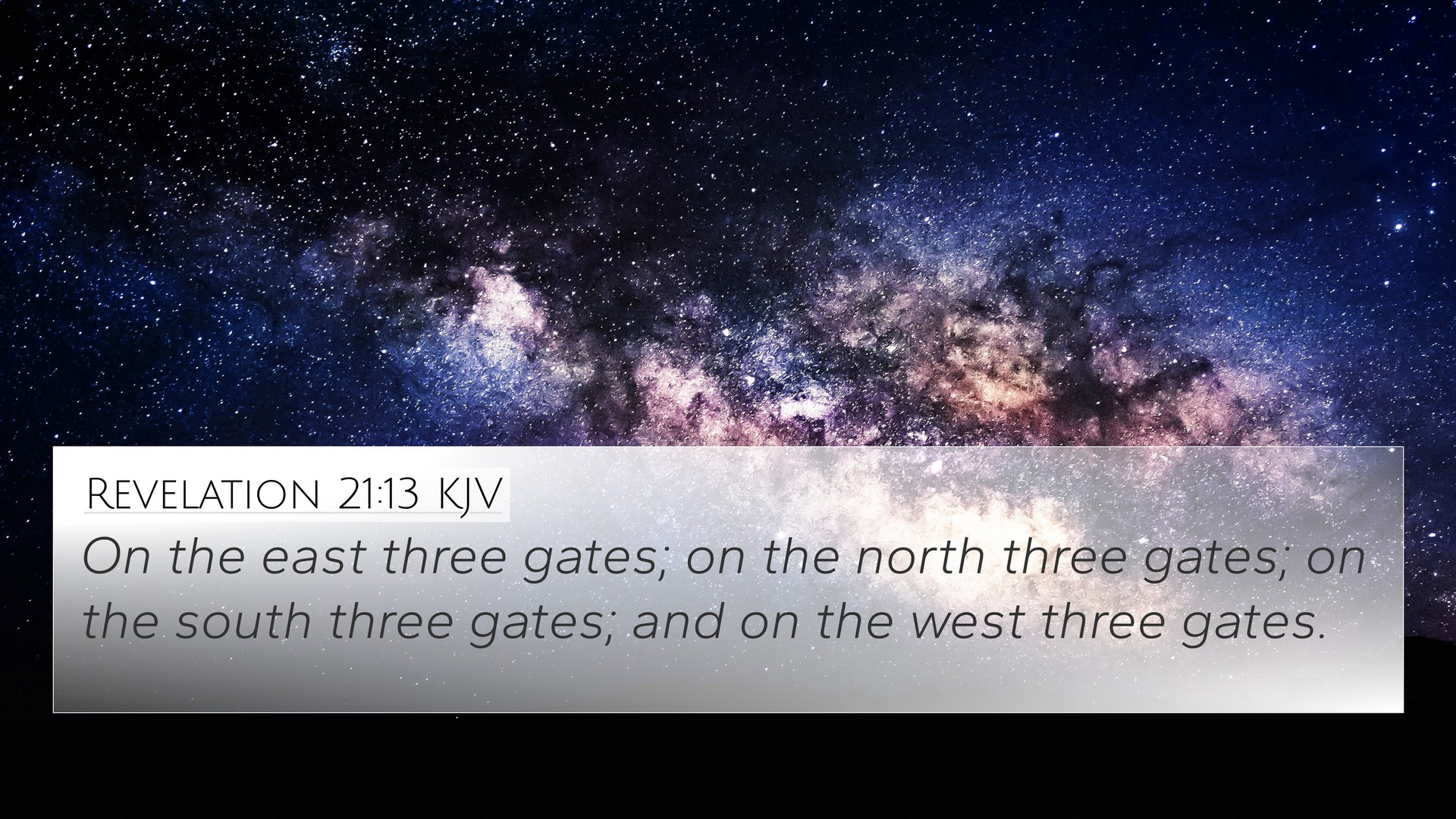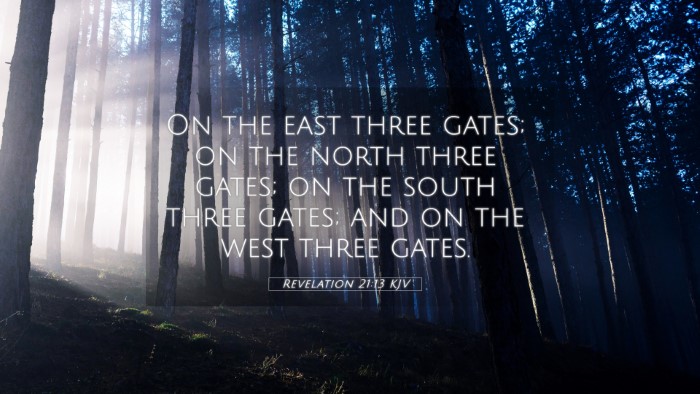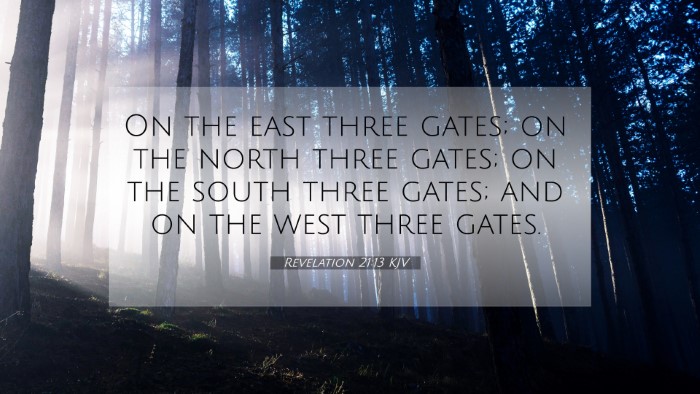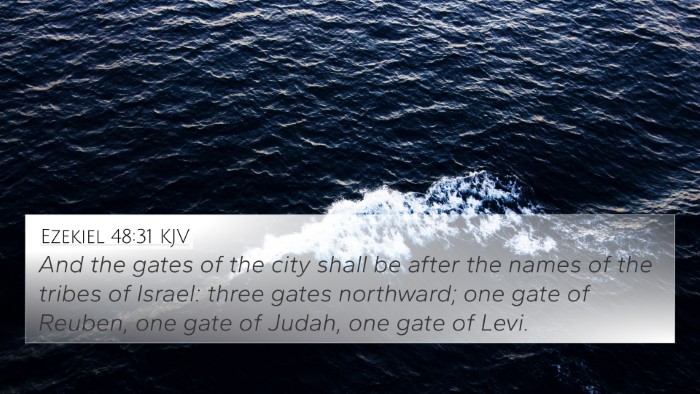Understanding Revelation 21:13
Revelation 21:13 states: "And had a wall great and high, and had twelve gates, and at the gates twelve angels, and names written thereon, which are the names of the twelve tribes of the children of Israel." This verse is rich in symbolic meaning, detailing aspects of the New Jerusalem. The insights drawn from various public domain commentaries provide a deeper understanding of this passage.
Summary of Insights
-
Matthew Henry's Commentary
Matthew Henry emphasizes the significance of the gates, noting that their presence signifies accessibility and the welcoming nature of God's kingdom. The twelve gates represent the twelve tribes of Israel, indicating God's covenant with His people and the inclusion of all of them in His eternal plan. The mention of angels at each gate signifies divine protection and guidance.
-
Albert Barnes' Notes
Albert Barnes further elaborates on the detail of the gates. He points out that the number twelve is a symbol of completeness and divine order. Each gate being assigned to a tribe illustrates God’s faithfulness to His promises and His recognition of the children of Israel, portraying how God’s people will ultimately be recognized and honored in His kingdom.
-
Adam Clarke's Commentary
Adam Clarke delves into the implications of the structure of the New Jerusalem. He describes the gates representing the different paths through which God's grace reaches humanity. The twelve angels symbolize the divine presence, ensuring that the gates serve as an invitation to the faithful and a barrier to those not aligned with God's will.
Cross-References with Related Bible Verses
To gain a fuller understanding of Revelation 21:13, several cross-references can provide thematic connections to other Biblical texts:
- Exodus 28:21 - Discusses how the names of the tribes of Israel are inscribed on the high priest's breastplate, emphasizing representation before God.
- Ezekiel 48:30-34 - Describes the layout of the land for the twelve tribes, which reflects the organized structure in the New Jerusalem.
- Hebrews 11:10 - Mentions a city whose builder and maker is God, tying the concept of the heavenly city to the New Jerusalem.
- Matthew 19:28 - Jesus' promise to the apostles that they will sit on thrones judging the twelve tribes, connecting the apostles to the foundational role of the tribes.
- Galatians 3:28 - Points to the unity of God's people, whether Jew or Gentile, creating parallels between God's inclusivity and the gates of New Jerusalem.
- Revelation 7:4-8 - References the sealing of the 144,000 from the tribes of Israel, illustrating God's protection and acknowledgment of His people.
- Revelation 21:12 - Mentions the gates of the New Jerusalem, further emphasizing God’s provision for His people and the access they have to His presence.
Thematic Connections
The themes presented in Revelation 21:13 resonate throughout Scripture:
-
Covenant and Community
The gates symbolize the community of God's people, stressing the continuity of God's promises from the Old Testament through to the New Testament.
-
Divine Order
The specific number of gates highlights the order in God’s creation and His plan for humanity.
-
God's Presence
The roles of angels at each gate reflect the ongoing divine assurance of God's presence among His people.
Practical Application for Study
For those studying the Bible, Revelation 21:13 opens avenues for:
- Performing a comparative Bible verse analysis to explore similarities and differences between related passages.
- Utilizing a Bible concordance to locate cross-references and deepen understanding of themes.
- Engaging in cross-reference Bible study methods to enrich personal or communal study sessions.
Conclusion
The gates mentioned in Revelation 21:13 serve as a profound symbol of God's promise, order, and protection over His people. By linking this verse with others throughout the Bible, readers can better appreciate the interconnectedness of God's word and the thematic richness that underpins Scripture. Applying tools for Bible cross-referencing will enhance understanding and reveal the tapestry of beliefs that unify different sections of the Bible.



